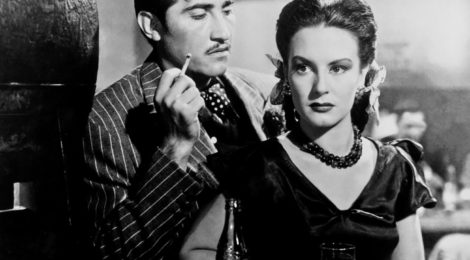
Countering Moral Orthodoxies in the Cabaretera: Music and Dance in Salón México and Aventurera
Today Mediático is delighted to present a videographic essay “Cabaretera Subtexts” by this website’s co-editors Catherine Grant (Birkbeck College, University of London) and Dolores Tierney (University of Sussex), offering a counter reading of a genre unique to Mexican cinema, the cabaretera (cabaret/brothel film). The accompanying text also highlights the season “Salon Mexico: The Golden Age of Mexican Cinema” playing at the BFI Southbank throughout July.
Countering Moral Orthodoxies in the cabaretera: Music and Dance in Salón México and Aventurera
by Dolores Tierney
Currently showing all throughout July at the BFI Southbank is a season of films from the Golden Age of Mexica Cinema. Featuring films made between 1934 and 1960, the season extends the span of this vibrant period in Mexican filmmaking slightly beyond its generally agreed upon parameters (1935-1955), but with good reason. It means the season can incorporate some gems from the pre-industrial era The Woman of the Port (Arcady Boytler 1934) and Two Monks (Juan Bustillo Oro, 1934) and Mexico’s first Academy Award contender Macario (Roberto Gavaldón 1960) in addition to other films from this period of immense expansion and popularity in the Mexican film industry. Called the ‘Golden Age’ the term refers not just to the relative dominance this cinema enjoyed in Spanish speaking markets across Latin America, the United States and Spain but also to its gilded and idealized representations of Mexican nationalism.
Featuring major stars (Dolores Del Rio, Maria Felix, Arturo de Córdova Pedro Armendáriz and Ninón Sevilla), directors (Emilio Fernández, Roberto Gavaldón, and Julio Bracho), and some of the distinctive genres –the cabaretera (cabaret/brothel film) and noir films– from the classical era, this season also challenges some standard assumptions about the Golden Age of Mexican cinema. La otra (The Other One Roberto Gavaldón) features Del Rio, the Grand Dame of Mexican cinema, known for playing noble and sometimes simple characters, embodying identical twins, one evil and the other good. The season, programmed by Features Editor at Sight & Sound James Bell, also counters the idea of Mexican cinema as a predominantly rural cinema, featuring films mostly set in Mexico’s visibly modern and modernizing urban centres (Mexico City, Guadalajara, Juárez). This emphasis on the very excellent urban films produced during this period presents a different canon of Mexican classical cinema in line with the current celebrations taking place globally, including retrospectives of Mexican noir at MoMA in New York and the Cinematheque in Melbourne.
In the spirit of challenging some assumptions made about Golden Age Mexican cinema the above video essay offers a counter-reading of a genre unique to Mexican cinema, the cabaretera (cabaret/brothel film). Like all films from the Golden Age, cabareteras are the product of the very specific political and ideological context of post-Revolutionary Mexico and also of the industrial context of a transnationalized Mexican cinema which adopted and adapted Hollywood codes and genres. In the early 1940s, under the administration of President Avila Camacho, the Mexican State supported culture and the arts as a major part of its programme of conservative cultural nationalism –including the burgeoning film industry– with the precise aim of promoting a positive and unified image of Mexico in the wake of its armed revolution. This positive and unified image of Mexico included a set of moral codes and norms defining proper roles for men and women.
The video essay explores moments in Salón México (Emilio Fernández 1949) and Aventurera (Tito Gout 1950), typical cabareteras in that they feature women as the breadwinners forced by growing economic hardship into sex work. Conventional readings suggest that these films deal with the economic crisis in patriarchy and in the ideals of the Revolution by forwarding an ideology of family orthodoxy and national unity, recuperating the other – the sex worker – within a narrative of conventional morality (Hershfield, 1996: 77). Taking a cue from Ana López’s seminal essay “Tears and Desire: Women and Melodrama in the ‘Old’ Mexican Cinema” (1993), this video essay reads musical and dance sequences in these films as offering a subtextual critique to the patriarchal narratives and dominant ideologies most commonly read into classical Mexican cinema: –loving close ups of a dance sequence in which the camera celebrates the forbidden spectacle of dance as sublimated sex, and music as a space of female subjectivity and protofeminist self-awareness.
References
Hershfield, Joanne (1996). Mexican Cinema, Mexican Woman 1940–1950 Austin: University of Texas Press.
López, Ana (1993) “Tears and Desire: Women and Melodrama in the ‘Old’ Mexican Cinema” in Manuel Alvarado, John King and Ana López (eds). Mediating Two Worlds: Cinematic Encounters in the Americas London: BFI, 147-164.







I grew up in Puerto Rico watching these movies and hoping to dress and look like these actresses . I was fourteen and envied the hairdos and dresses.
Congratulations, I love this! The fetishistic focus on dancing feet in the first film, the women manoeuvering so deftly on implausibly high heels; and Ninón stalking the stage in the second, so effortlessly superior to the men who sing to her or stare at her.
Dear Paul
Glad you liked it. Katie and I had fun working on it together!
Fetishistic is exactly the word I use when I talk about this sequence in Chapter 5 of my Fernandez book. I talk quite a bit about high heels actually. I also talk about Ninon and this scene in that chapter too.